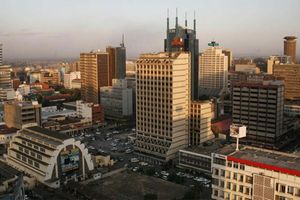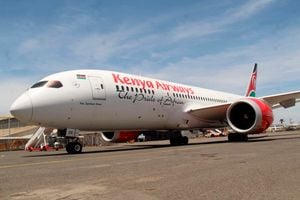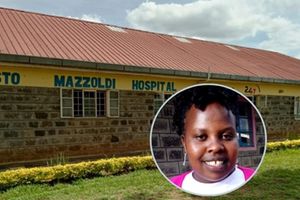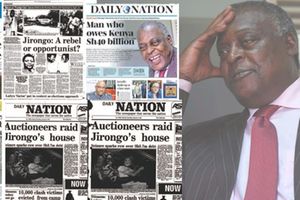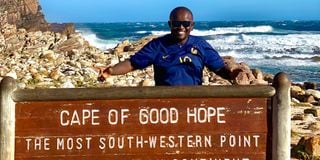
Victor Matara on a beach in South Western Cape, South Africa. PHOTO | POOL
How random and far would you stage an overland to satisfy your adventure curiosity?
For an intrepid soul like Victor Matara, a digital marketing consultant, nothing could possibly stop him from covering the face of the earth for a cultural enriching and time-liberal journey.
Having covered every inch of Kenya’s landscape, it was time to spice his overland adventures.
For 52 days, driving a Subaru XV 2014, Matara snaked through nine countries - Kenya, Tanzania, Zambia, Zimbabwe, Malawi, Namibia, Botswana, Lesotho and South Africa - covering 13,398 kilometres while spending Sh263,555 worth of fuel on his odyssey to Cape Town, South Africa from Nairobi.
“I’m an avid traveler. I do random trips a lot. I have road tripped to every part of this country you can think of. I never really plan for these trips, they just happen. My recent one is the Nairobi – Cape Town,” Matara vaunts.

Victor Matara celebrates during his Cape Town, South Africa visit. PHOTO | POOL
By flying, Matara would have spent Sh110,900 on a 5 hours 45 minutes fight to Cape Town on a round trip if he booked an economy class on Kenya Airways.
“For the longest time I have always wanted to go to Cape Town, not by air, but road because I believe an overland offers you immense opportunities to explore more. For me it’s never about the destination but enjoying the journey. I mean take videos and pictures of places, make random stops, interacts with the locals, enjoy their cuisines and such kind of adventures. Nairobi to Cape Town offered that thrill in abundance. It was a bucket list item that had been nagging and needed to be ticked off,” he adds.
To enjoy the journey, Victor and his compadre could afford as many days as they would need.
“We did a lot of stops because we were not rushing, we had a lot of time. My friend Vincent and I are freelancers, so we worked remotely. We would get jobs while on the trip, make a stopover, complete the assignment even if it took days, and then resume the journey,” he says.
For this to be effective, the two had to ensure they had good internet access at any given time.
“Malawi has the cheapest internet data rates, that’s what we discovered.Nonetheless, Kenya has the best internet which you will definitely miss as you travel further South. To ensure we were never out of internet (connection), the first thing we did at every border point is get two local different local sim cards. The locals were always kind enough to advise us on which was the best to use.”
When this pilgrimage panned out, Victor and his friend needed a few paraphernalia for the overland; a tent, passport, yellow fever card, Car logbook, Comesa insurance cover which came handy in Malawi and Zambia, International Driving Permit (IDL), Covid-19 certificates and car breakdown recovery kits.
They were also armed with a Carnet de passage en Douane, a car passport that aids with border crossings and custom clearance.
“I also did some modification on the car to withstand bad roads. I changed the coil springs because I had earlier on learned that roads in Malawi and Zambia are pathetic. I also changed the shock absorbers and sump guard to sustain the journey. These modification cost Sh100,000, give or take, not including servicing the car,” Victor continues.
The odyssey began on October 17, 2023 with Namanga being the first border point to cross. It was seamless and smooth.
“Crossing to Tanzania we spent five days there, Iringa was one of my favourite places in that country. I loved the food and the topography is scenic, it’s all green and coming from a green region that was captivating. In general, we experienced the best hospitality in Tanzania in the entire journey.”
The next border point was Tunduma-Nakonde which emptied the two souls into Zambia.
“That was the worst border point we had to cross. There is a lot of bureaucracy on that border. The crossing procedures aren’t streamlined. Tell me why we had to spend four hours to just get cleared. There was so much paper work to do and payments are made in cash. Processes aren’t modern on that border. Can you imagine some payments we had to make in dollars, something which also happened in Malawi when we had local currencies? Why? Because the authorities insisted on having the dollar,” Victor smacks.
Close to Sh15,000 was spent on this particular tiring and torturous border post.
“We paid 200 kwacha (Sh1,400) as Interpol charges, road poll charges cost us $20 (Sh3,200), car search and scan had us part with 100 kwacha (Sh700), Carbon tax was 370 kwacha (Sh2,600) if the car fuel capacity is higher than 1500ccs. Then the council levy was 50 kwacha (Sh350) and an agent facilitation fee of 650 kwacha (Sh4550). Let me tell you, an agent here is inevitable,” Victor elaborates.
But it was the Namibia-Malawian (Mwami/Mchinji) border where they spent Sh7,000 that had Victor feeling they had been robbed.
“Processing fee was 20,000 Malawian kwacha, carbon tax 8,000 kwacha. The toll fee $20. For some reason, I found this border to be very expensive. Crossing you will buy currencies at very bad rates. One Kenya shilling is equivalent to 10.56 Malawian kwachas and for the $20 I bought it at 46,000 kwachas.”
Even though travelling cashless is somehow safer. Victor and Vincent found it very cumbersome whenever they had to withdraw money at ATMs on the borders points. He laments was shocked by the ‘over the roof’ transaction charges.

Victor Matara at the Kopfontein border crossing into South Africa from Botswana. PHOTO | POOL
Charges for entering Botswana from Zambia stood at Sh6,820 compared to Sh3,300 while crossing to Namibia and Sh670 when driving into Lesotho.
“It’s visa free for Kenyans in Lesotho. We used Maseru Bridge Border post, another seamless border crossing just like the Noordoewer border post when entering Namibia.”
The only borders they did not pay a cent were South Africa and Kenya- Tanzania courtesy of the two countries being East Africa Community members.
“We spent another five days in Zambia, the home to Victoria falls, which is actually on the border of Zambia and Zimbabwe. Victoria Falls is a must-visit if you travelling south. I would pay to see those falls again. There was also much food in Zambia that made us forget the crazy toll fees and their bad roads. So many gigantic pot holes every few miles. Zambia was the only country where we were served with so much food. I guess it must have played part in the 13 kilos I gained during this trip,” he says smiling.
What they realised is that the more they approached south, the more the cuisine turned from good to bad.
“Past Zambia coming by really nutritious local food becomes an extreme sport. We feasted on so much junk because we couldn’t find organic meals. It was tiring and boring,” he says.
In Malawi their experience was soured by rogue police out to extort foreigners for bribes and unforgiving bad roads that Victor claims even with a four wheel drive, one will still have to suffer.
Botswana was another country that left a lasting impression in Victor and Vincent minds.
“I have never seen such so many elephants on the road loitering. There are also very few locals on the road, I understand Botswana is one of the most sparsely populated countries in the world so that made sense. There are fewer cars on the road than any other place and the roads are super good. The architectural diversity in Botswana capital Gaborone also fascinated us. The buildings are so modern and new, it’s like they are cleaned every day. The city is well planned,” he goes on.
But its Cape Town that left an indelible mark on the compadres sight visits and voyage.
“South Africa is an advanced country miles ahead with beautiful landscapes, especially in the Western Cape region. The hype about South Africa is real. Arguably the most advanced country I have ever visited in Africa. I can’t stop thinking about the white beaches in Cape Town, Robben Island, the helicopter ride of the city courtesy of South Africa Tourism who became our host just because they realised we were sharing so much about our journey. Would I do it again? Absolutely! Can’t wait to explore the Eastern side of South Africa especially Mpumalanga, Durban,” he concludes.

